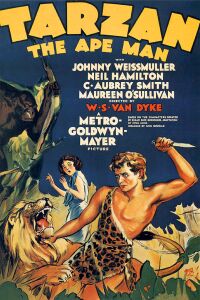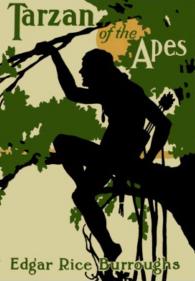Related Research Articles

Greystoke: The Legend of Tarzan, Lord of the Apes is a 1984 adventure film directed by Hugh Hudson based on Edgar Rice Burroughs' novel Tarzan of the Apes (1912). Christopher Lambert stars as Tarzan and Andie MacDowell as Jane; the cast also includes Ralph Richardson, Ian Holm, James Fox, Cheryl Campbell, and Ian Charleson.

Despite having a flourishing Chinese and Malay film industry in the 1950s and 1960s, Singapore's film industry declined after independence in 1965. Film production increased in the 1990s, which saw the first locally produced feature-length films. There were a few films that featured Singaporean actors and were set in Singapore, including Saint Jack, They Call Her Cleopatra Wong and Crazy Rich Asians.

Tarzan is a 1999 American animated coming-of-age adventure comedy-drama film produced by Walt Disney Feature Animation and released by Walt Disney Pictures. It is based on the 1912 story Tarzan of the Apes by Edgar Rice Burroughs, being the first animated major motion picture version of the story. The film was directed by Kevin Lima and Chris Buck and produced by Bonnie Arnold, from a screenplay by Tab Murphy and the writing team of Bob Tzudiker and Noni White. It stars the voices of Tony Goldwyn, Minnie Driver, Glenn Close, Rosie O'Donnell, Brian Blessed, Lance Henriksen, Wayne Knight, and Nigel Hawthorne.
Third Cinema is a Latin American film movement that started in the 1960s–70s which decries neocolonialism, the capitalist system, and the Hollywood model of cinema as mere entertainment to make money. The term was coined in the manifesto Hacia un tercer cine, written in the late 1960s by Argentine filmmakers Fernando Solanas and Octavio Getino, members of the Grupo Cine Liberación and published in 1969 in the journal Tricontinental by the OSPAAAL.

Tarzan the Ape Man is a 1932 pre-Code American action adventure film released by Metro-Goldwyn-Mayer featuring Edgar Rice Burroughs' famous jungle hero Tarzan and starring Johnny Weissmuller, Neil Hamilton, C. Aubrey Smith and Maureen O'Sullivan. It was Weissmuller's first of 12 Tarzan films. O'Sullivan played Jane in six features between 1932 and 1942. The film is loosely based on Burroughs' 1912 novel Tarzan of the Apes, with the dialogue written by Ivor Novello. The film was directed by W.S. Van Dyke. Metro-Goldwyn-Mayer released two remakes of Tarzan, the Ape Man in 1959 and in 1981, but each was a different adaptation of Rice Burroughs' novel. It is also the first appearance of Tarzan's famous yell.

The Cinema of the Philippines began with the introduction of the first moving pictures to the country on August 31, 1897, at the Salón de Pertierra in Manila. The following year, local scenes were shot on film for the first time by a Spaniard, Antonio Ramos, using the Lumiere Cinematograph. While most early filmmakers and producers in the country were mostly wealthy enterprising foreigners and expatriates, on September 12, 1919, Dalagang Bukid , a movie based on a popular musical play, was the first movie made and shown by Filipino filmmaker José Nepomuceno. Dubbed as the "Father of Philippine Cinema," his work marked the start of cinema as an art form in the Philippines.

The cinema of Thailand dates back to the early days of filmmaking, when King Chulalongkorn's 1897 visit to Bern, Switzerland was recorded by François-Henri Lavancy-Clarke. The film was then brought to Bangkok, where it was exhibited. This sparked more interest in film by the Thai Royal Family and local businessmen, who brought in filmmaking equipment and started to exhibit foreign films. By the 1920s, a local film industry had started and in the 1930s, the Thai film industry had its first "golden age", with a number of studios producing films.

Tarzan of the Apes is a 1918 American action/adventure silent film directed by Scott Sidney starring Elmo Lincoln, Enid Markey, George B. French and Gordon Griffith.

The Irish film industry has grown somewhat in recent years thanks partly to the promotion of the sector by Fís Éireann/Screen Ireland and the introduction of heavy tax breaks. According to the Irish Audiovisual Content Production Sector Review carried out by the Irish Film Board and PricewaterhouseCoopers in 2008 this sector, has gone from 1,000 people employed six or seven years ago, to well over 6,000 people in that sector now and is valued at over €557.3 million and represents 0.3% of GDP. Most films are produced in English as Ireland is largely Anglophone, though some productions are made in Irish either wholly or partially.

Cinema in Cambodia began in the 1950s, and many films were being screened in theaters throughout the country by the 1960s, which are regarded as the "golden age". After a near-disappearance during the Khmer Rouge regime, competition from video and television has meant that the Cambodian film industry is a small one.

Middle Eastern cinema collectively refers to the film industries of West Asia and part of North Africa. By definition, it encompasses the film industries of Egypt, Iran, Bahrain, Iraq, Israel, Jordan, Kuwait, Lebanon, Palestine, Oman, Qatar, Saudi Arabia, Syria, United Arab Emirates, and Yemen. As such, the film industries of these countries are also part of the cinema of Asia, or in the case of Egypt, Africa.

The cinema of Indonesia refers to films produced domestically in Indonesia. The statutory Indonesian Film Board, or BPI, defines Indonesian films as "movies that are made by or using Indonesian resources whose Intellectual Property Right is owned either entirely or partly by Indonesian citizen or Indonesian legal entity".

The cinema of Lebanon, according to film critic and historian Roy Armes, is the only other cinema in the Arabic-speaking region, beside Egypt's, that could amount to a national cinema. Cinema in Lebanon has been in existence since the 1920s, and the country has produced more than 500 films.

Tarzan is a fictional character, a feral child raised in the African jungle by the Mangani great apes; he later experiences civilization, only to reject it and return to the wild as a heroic adventurer.
The inaugural moment of Syrian cinema is said to be the release of Al-Mutaham al-Bari in 1928. Actors from neighboring countries, as well as France, have influenced the Syrian film industry.

Tarzan is a series of 24 adventure novels written by Edgar Rice Burroughs (1875–1950) and published between 1912 and 1966, followed by several novels either co-written by Burroughs, or officially authorized by his estate. There are also two works written by Burroughs especially for children that are not considered part of the main series.

Tarzan is a 2013 English-language German computer-animated action-adventure film written, directed and produced by Reinhard Klooss and released on October 17, 2013 in Russia. The film was released across early 2014 in other countries. The film stars the voices of Kellan Lutz, Spencer Locke, Anton Zetterholm, Mark Deklin, Joe Cappelletti, and Jaime Ray Newman. The screenplay was written by Reinhard Klooss, Jessica Postigo and Yoni Brenner. The film is based on the novel Tarzan of the Apes (1912) by Edgar Rice Burroughs. The film grossed $44 million worldwide despite receiving predominantly negative reviews from critics. Tarzan was released on DVD and Blu-ray on August 5, 2014 by Highlight Film.
The ICFF is a not-for-profit, publicly attended film festival in Toronto, Ontario, Canada, programming international films and taking place during the summer. Founded in 2012, ICFF has grown from a four-day, single-venue festival of 18 films, to a 10-day, nine-city festival of over 130 feature films, documentaries and short films.

The cinema of Costa Rica comprises the art of film and creative movies made within the nation of Costa Rica or by Costa Rican filmmakers abroad.

Cinema in Qatar is a relatively young industry that evolved as part of the country’s plans to develop different local sectors with the aim of accumulating international recognition and status. Many major steps were taken to implement a long-term plan to develop the infrastructure as well as giving opportunities to local talents to have a platform that establishes their presence within the film industry with the support of the Doha Film Institute, and their various grants, workshops and festivals. The Qatar National Vision 2030 has three major pillars to development: human, social economic and environmental; this vision provides frameworks that enable the development of different elements within Qatar and its society; one of which is the high importance put on developing and cultivating artistic talents to represent and define Qatar on a global scale. Another important element in developing the movie industry is the influence and vision of Sheikha Al Mayassa who founded Doha Film Institution; the establishment of film as a mode of storytelling was imperative because it serves the purpose of granting Qatar a global presence through the talents that are supported and cultivated because of her initiative. The film industry plays a role in amplifying the Qatari national identity alongside the identity of the Arab world as a whole.
References
- ↑ "Seychelles Film Classification and Permit Office – Seychelles National Institute Of Culture Heritage & The Arts" . Retrieved 2024-06-18.
- ↑ Canby, Vincent (1981-08-07). "BO DEREK AS JANE IN 'TARZAN THE APE MAN' 'Tarzan the Ape Man'". The New York Times. ISSN 0362-4331 . Retrieved 2024-06-18.
- ↑ "Seychelles films classification board – new approach for 2024". www.nation.sc (in Bulgarian). Retrieved 2024-06-18.
- ↑ "Premiere of film "A Love Like This" -Archive -Seychelles Nation". www.nation.sc. Retrieved 2024-06-18.